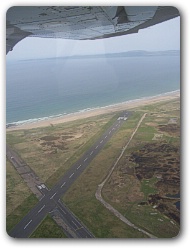|
Caernarfon-Islay
Friday 21st May, 2010
We drove over to Caernarfon on the
Thursday afternoon in brilliant sunshine.
On arrival at the Bryn Mor Beach
guest house we were greeted by the proprietor.
Having not had any lunch I was starving so he
quickly rustled up sandwiches and cold drinks.

Then we settled down to a flight planning session.
Our first port of call in Scotland was going to be
Islay (pronounced eye-la) and Brian had already
done the trip in August 2009 via the mainland
including the low level Manchester corridor.
Having debated the pros and cons we
decided on a route to the Isle of Man, across to Wigtown
(avoiding the danger areas) and then to the TRN VOR.
Finally a direct route to Islay.
After dinner we took a stroll down the beach to
Caernarfon airport, our departure airfield.
At this point I was to be reminded of the fickelness
of the local weather. Within the preceding few hours the coast
had become fog bound.

By the time we left the next morning after a hearty
breakfast the sun was shining again. We
arrived at the airfield early to meet up with Andy Reay,
a friend of Brian's (and one of Caernarfon's flying
instructors\examiners) who was going to be joining
us on the trip.
We completed the flight planning and after
two trips to the car for our luggage
we were ready to depart.

Having purchased a C172 checklist I proceeded with the
checks under Andy's watchful eye. The last time I'd flown this aircraft type
was in Thailand from Bang Phra airport, in November 2009.
The main differences were the high wings (I'd
need a ladder to check the fuel!), the throttle, electric flaps
and the damn rudder peddles that made steering the plane on
the ground feel more like trying to steer a tank!
Andy helped me to stay on track to the runway and at 9.40 am we were
up in the air negotiating a MATZ penetration with RAF Valley.
The controller was very busy with a Hawk jet in the circuit and asked us
to report not below 2,000 feet (presumably for circuit height and separation).
Then we were asked to orbit south of the runway to avoid the jet.

After what seemed an eternity we eventually cleared the MATZ and
I climbed to my planned flight level (FL045). I changed to my heading
of 002 at 9.57.
We said farewell to Valley and hello to Ronaldsway who provided
us with a Basic Service and cleared us to cross their zone VFR at FL045.
We were asked to squawk 4555; the Ronaldsway QNH was 1033.
By now the horizon was particularly vague through the haze
and I found myself relying on the instruments as we headed out
across the Irish Sea.
On approaching the Isle of Man at 10.21 we noticed
the conversation below us was very much focused on the "shiny new
taxiway" at Ronaldsway airport. Compliments were being exchanged
at a dizzying rate between the pilot of a Dash 8 and the ATC.

In order to maintain separation with the Dash 8 we were
asked to take up a heading of 310°, then a heading of
360° before finally being advised to resume our own
navigation to Wigtown.
We managed to let ATC know we were passing overhead the VOR
(6 miles west of the airfield) and
soon after clearing their airspace we were asked to freecall
Scottish Information on 119.850.
Scottish Information asked us to report at the TRN (Turnberry) VOR,
squawk 4504 and climb not above 5,000 feet on the Glasgow QNH.
(Scottish TMA altitudes are based on the latter).

At this point I was tracking to the DCS (Dean Cross) VOR 355° radial and
needed to change heading to 015° for Wigtown. We arrived at this
waypoint on time at 10.45. I was cleared to climb FL050 on this
leg for quadrantal compliance and handed on to Scottish Control on
127.275 who asked us to squawk 3605.
From Wigtown we tracked the 340° radial to the TRN VOR and
arrived at 11.07. From there I changed heading to 291° for Islay
and we passed Ailsa Craig to the south of us,
an island where blue hone granite is
quarried to make curling stones.

As we approached the island of Islay we changed frequency to the
Islay AFIS and advised
we were inbound to land. Initially we were instructed to join on the
downwind leg for runway 13 but realised our descent to circuit height
would take us through a wall of low level cloud and obliterate
our view of of the runway.
We quickly decided to request an overhead join which was granted. As I
descended on the dead side I took in the view below me. A wonderful island
with spectacular runways at the airfield.

As I descended on final over the sea for an uneventful landing on 13
the surface wind was 150°/18 knots.
After parking up (the flight had taken 2hrs
15 minutes) we went to the tower to pay the landing and met
a cheery Air Traffic Controller.
After lunch in the Drome Cafe
we perused the fine displays of
single malt whiskey (produced by no less
than eight local distilleries) the island was renowned for.
Unfortunately not a drop could be purchased inside the
airport and I noticed later in my 'Rough Guide to the Scottish
Highlands and Islands' that there is an annual festival
of music and malt the last week of May, early June called
Feis Ile
|

 Home
Home Scotland Landing Page
Scotland Landing Page